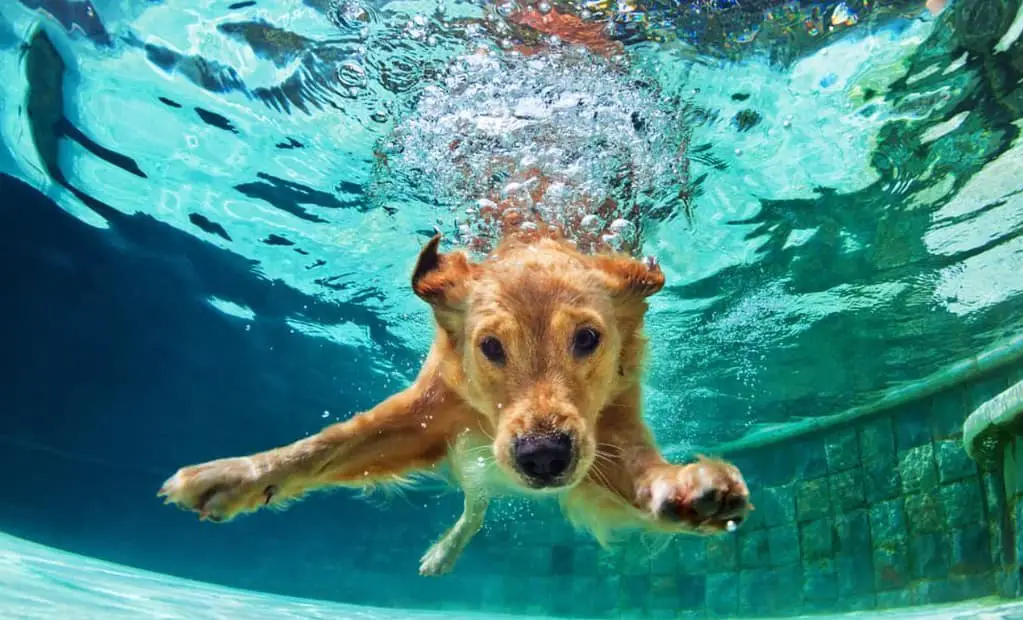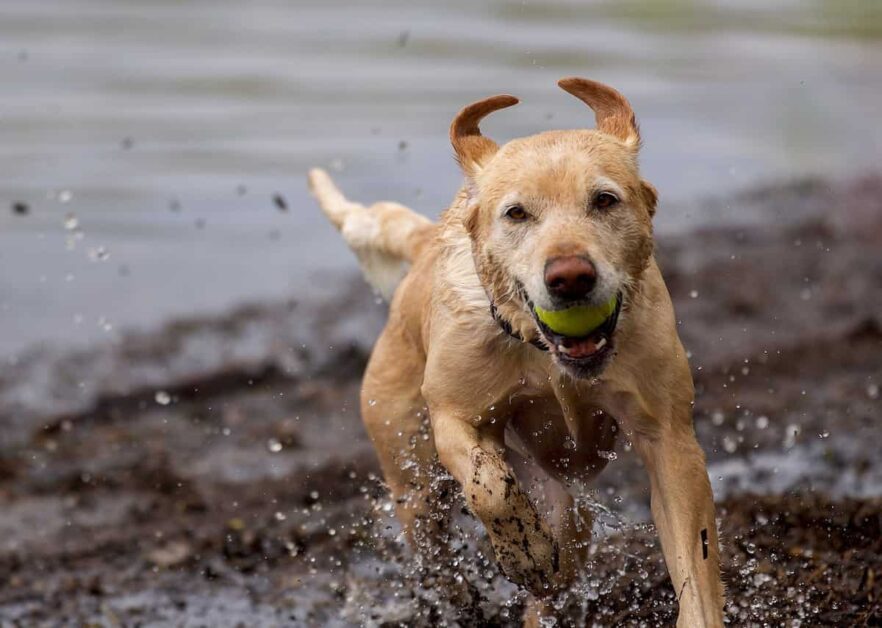Labrador retrievers are known for their high energy levels and require considerable exercise to stay healthy. But how much exercise do labs need? The amount of exercise needed varies, but a healthy adult Labrador needs at least an hour daily, with some requiring more.
However, puppies and senior Labradors need less strenuous exercise, but it is still crucial to provide them with enough physical activity to keep them active. According to the American kennel club, they are the 2nd most popular dog breeds as of 2023.
Physical and mental exercise is recommended to tame their excess energy. Engaging in activities such as playing fetch, walking, and training sessions can help to keep them mentally stimulated and happy, in addition to preventing weight gain and related health issues.
Exercise Needs Of Labrador Retrievers
Labradors are a popular dog breed originally bred for hunting and retrieving. Hence, they require plenty of exercise to remain physically and mentally fit.
History And Purpose Of Labs
Labrador Retrievers have a rich history dating back to the early 19th century. These intelligent and hardworking dogs were originally bred in Newfoundland, Canada. They retrieved fishnets and helped fishermen with their tasks on icy waters.
The original purpose of Labs as skilled retrievers is to make them highly active dogs that crave physical activity. Their innate abilities extend beyond waterfowl hunting and now include search-and-rescue missions. They assist specially-abled, bomb detection work, and more.
Physical And Behavioral Traits Of Labs
Labrador Retrievers were originally bred as working dogs, designed to retrieve from water and land. Hence Labs strongly desire to be physically challenged and mentally stimulated.
In addition to their physical characteristics, Labrador Retrievers possess sociable personalities and are known for their friendly nature. They greatly benefit from human interaction and love, making them ideal family companions.
Without enough daily exercise or mental stimulation, Labs can get boring. It can lead to destructive behavior like digging or chewing on furniture.

What Are Recommended Exercise Guidelines For Labs?
To ensure your Labrador remains healthy and happy, they must receive at least 2 hours of exercise daily. Running, swimming, and playing fetch are excellent activities.
Daily Exercise Requirements Based On Age, Size, And Activity Level
The exercise requirements for labradors depend on their age, size, and activity level. For senior labrador retrievers, it is recommended to have around 2 hours of daily brisk walks, jogging, or playtime.
However, the amount and intensity of exercise should be adjusted based on each dog’s needs. More active labs may require higher exercise needs, while senior labs may need less intense activities like swimming or shorter walks. Consistent long walks is essential in preventing obesity, which can cause joint issues and heart disease in dogs.
Types Of Exercises For Labs
Here are some exercises perfect for dog breeds like labradors:
- Walks – A daily labrador walk keep their muscles strong and minds active. Try different routes or terrains to keep it interesting.
- Running – Labs love to run, so jogging or running will burn off pent-up energy. Do not over-exercise.
- Swimming– Labradors were bred as water retrievers and loved swimming! A swim in the pool, lake, or ocean is a fun exercise for Labs.
- Fetch – Play fetch to keep the Labrador retriever moving. It will burn off pent-up energy and keep the dog entertained.
- Tug-of-war – Tug-of-war is a fantastic way to bond with your Labrador retriever while giving them some exercise.
- Agility Training– It promotes physical activity, strength, flexibility, coordination, balance, and mental acuity in dogs.
- Obedience Classes – Obedience training can be a good way of teaching manners and discipline to your dog.
- Dog Sports – Flyball, disc dog competitions, and canine freestyle routines are a few labrador exercise examples. It provides dogs with emotional satisfaction and physical health benefits.

How to Provide Indoor Exercise For Your Dog?
Understandably, sometimes you cannot take your lab puppy out for walks. However, ensuring your furry friend gets enough physical and mental stimulation through exercise is important. Fortunately, you can make indoor exercise enjoyable for your lab with creativity.
You can use a treadmill for dog exercise. First, make them comfortable with its sound and feel. Make them sit on it when it’s stationery to get started. Eventually, they learn to run alongside you.
An obstacle course can be created using everyday items found at home, a great way to enhance problem-solving abilities and promote a healthy heart. Climbing old boxes can be incorporated into the course. Dog sports are enjoyable.
Your lab puppy will love the hide-and-seek game at home. Hide a treat and let your labrador retriever get it. Do not make it too easy or hard, as they may lose interest.
Importance Of Mental Stimulation
Providing mental stimulation is just as crucial as Labrador exercise. These dogs were specifically bred for work and require ample mental engagement to thrive.
Training sessions, obedience training, puzzle toys, and games like hide-and-seek can provide great mental stimulation for Labs. Varied exercise routines can keep their minds active. Mix up walks with runs or take them on different routes in the neighborhood. Active playtime with owners or other dogs engages a Labrador’s mind and prevents them from being overweight dog.
Toys And Games For Mental Stimulation
Mental stimulation is as important as physical exercise for Labradors. Here are some fun toys and games you can try with your furry friend:
- Puzzle Toys – These toys are designed to challenge their brains. They will need to solve a puzzle to get a reward.
- Hide-and-Seek – Hide treats around the house or backyard, and encourage your Labrador to find them.
- Snuffle Mats – These mats are made of fleece strips. It makes it difficult for dogs to find the hidden treats.
- Tug-of-War – This game can help build trust between you and your Labrador besides providing a great workout.
- Interactive Balls – These balls come with puzzles inside. It requires your dog’s attention to release the treats.
- Scent Training – Labrador retrievers have an excellent sense of smell. Hiding scented objects around the house can be a great way to provide mental stimulation.
- Teach New Tricks – Labrador retrievers love learning new things. Take some time daily to teach them new commands or tricks.

How to Exercise Your Lab: Tips and Techniques
Provide safe and enjoyable activities to ensure your Labrador retriever gets the appropriate exercise. Here are some tips and techniques:
Start Slowly
If your Labrador retriever is not used to it, start slowly with light exercise. Gradually increase the duration and opt for more vigorous exercise. It will prevent injuries and help your Lab adjust to its new routine. Remember that a senior labrador retriever needs less strenuous exercise than an adult lab.
Mix it Up
Keep your dog active with various activities to keep your Labrador retriever active. It can include walking, running, swimming, playing fetch, and agility training.
Environment
When selecting activities, it’s important to consider your surroundings. Walking or running on sidewalks and in parks is a great choice if you live in a city or suburban area. On the other hand, hiking or running on trails may be a better fit for you if you reside in a rural area.
Use Appropriate Gear
Ensure your Lab has appropriate gear like a collar or harness, leash, and water bottle. Reflective gear is important for walking or running in low-light conditions.
Monitor Your Lab’s Health
Regularly check your Lab for signs of fatigue, dehydration, or injury. If your Labrador retriever experiences health issues, consult your veterinarian before exercising.
Pay Attention To Pet’s Signals
Be alert about your dog’s exercise needs and understand their non-verbal signs and body language. Do not force your yellow lab puppy to do anything they don’t like. Know when it ok to exercise and when not. If your labrador puppy is ill or off, give them an off day.
Form An Exercise Routine
Maintaining a healthy adult labrador retriever comes from regular exercise. Make your labrador retriever start walking at a young age. Take them out regularly and at the same time.
It will help create your labrador’s exercise pattern. Your labrador puppy may not run along with you initially. Start gentle walking on a leash and increase their time gradually.
Focus On Having Fun
A labrador puppy wants to have fun. They may stop the activity and not cooperate if it is not interesting. Include treats and praise to make exercise sessions fun. Most dog breeds respond well to positive treatment, like physical affection and verbal affirmation.
How many hours of exercise do lab puppies need?
A labrador puppy requires less exercise than adult Labrador retrievers. It is because their bones and joints are still developing. Excessive exercise causes growth problems, so follow these guidelines for a lab puppy:
8-12 Weeks Old
15-20 minutes of activity 2-3 times daily is how much exercise they need. This can include short walks, playing fetch in the yard, and playing with toys.
3-6 Months Old
Your Lab puppy can handle slightly more exercise at this age. It’s still important not to overdo it. 20-30 minutes, 2-3 times daily, is how much exercise a labrador need when 3-6 months.
6-12 Months Old
Your Lab puppy can handle more exercise now. Continue monitoring their activity levels. 30-45 minutes, 2-3 times daily, is how much exercise a labrador need at this age.
How many exercises Do Adult Labs Need?
Adult dogs require more exercise than labrador puppies. Around 1-2 hours of exercise per day is needed.
Walking and Running
Labrador retrievers are great running partners, and they enjoy brisk walks. Aim for 30-60 minutes of walking or running daily. You can also split the time into two shorter walks.
Swimming
Labrador retrievers are natural swimmers and enjoy water-based exercise. Swimming is a low-impact exercise. It is easy on their joints and provides excellent cardiovascular benefits. Aim for 20-30 minutes of swimming daily.
Playing Fetch
Play fetch with your labrador retriever for good health. Monitor the game’s intensity and do not over-exercise these dog breeds. 15-20 minutes of playing fetch is how much exercise you must aim for.

Benefits Of Regular Labrador Exercise
Daily exercise improves physical health, reduces behavioral issues, and strengthens the bond between most dog owners and pets. Whether it is a yellow lab or a black lab, exercise keeps the dog healthy.
Improved Physical Health
Giving your Labrador puppy enough exercise is essential for their physical health. Routine exercise helps manage weight and reduces the risk of heart disease and joint issues later in life.
Incorporating various activities into your Lab’s daily routine improves overall fitness. Playing games like fetch and frisbee toss or walking regularly is great. Consider taking them on hikes or runs for vigorous activity sessions. It will challenge their cardiovascular system and build endurance.
Reduced Behavioral Issues
Regular exercise significantly reduces behavioral problems in Labrador Retrievers. Labs that don’t get enough physical activity reflect destructive behavior.
Exercise helps Labradors release pent-up energy and promotes relaxation. It leads to improved behavior at home. A good game of fetch is physically stimulating and mentally challenging. They must retrieve an object and bring it back to its owner.
Stronger Bond With Dog Owners
Daily exercise can do wonders for your bond with your beloved Labrador retriever. Dogs thrive on routine. Structured exercise, like daily walks, can make a difference.
Another way regular exercise strengthens the bond is through increased socialization opportunities. Taking your dog for walks exposes them to various new smells, people, sounds, dogs, and situations. They help them learn how to react better in socially appropriate ways.
What Are The Signs Your Lab Needs More Exercise
Destructive behavior, excessive barking, restlessness, or weight gain are signs to reassess an exercise routine.
Destructive Behavior
Labradors are lively and energetic dogs. They can become bored and prone to destructive behavior without enough physical exercise. Chewing on furniture or shoes, digging holes in the yard, or excessively barking are a few examples.
Enough physical activity can help reduce its destructive tendencies. Along with regular walks, incorporate games like fetch or tug-of-war to burn off pent-up energy. Provide mental stimulation through training exercises or treat puzzles to your lab puppies.
Excessive Barking
If your Labrador is barking excessively, it is a sign that the amount of exercise you give them is insufficient. Labradors are active dogs and must release it through physical activity.
Regular exercise can reduce or eliminate this behavior. A tired dog is happy. An exercised Labrador is less likely to bark constantly out of frustration or boredom.
Restlessness
If your Labrador seems restless and unable to calm down, they need more exercise. Labrador retrievers become anxious and restless when they do not receive sufficient exercise.
You can tell if your dog needs more exercise by signs like restlessness, pacing around the house, or circling you repeatedly.
Weight Gain
Your labrador can gain weight if they aren’t getting much exercise. Labrador retrievers tend to overeat and become overweight quickly if they don’t burn off those calories.
Obesity can lead to serious health issues for dogs, including joint problems, heart disease, and diabetes. Provide sufficient exercise and monitor their diet and portion sizes. Regular exercise not only helps prevent obesity but also improves overall behavior. This is a common phenomenon in an old labrador.
Signs of Over-Exercising Your Lab
Monitor your Lab’s exercise levels to ensure they are not over-exercising. Signs of over-exercising can include:
- Limping or favoring one leg
- Refusal to move or lethargy
- Rapid breathing or panting
- Excessive thirst or dehydration
- Vomiting or diarrhea
- Loss of appetite
If you notice these signs, reduce your lab’s exercise and consult your veterinarian.
Common Questions About Exercise For Labs
Here are the most commonly asked questions about exercise for Labrador retrievers. A few examples are how much exercise they need on a leash, and if indoor exercise is enough.
How Much Exercise Does A Lab Need On A Leash?
There are no hard and fast rules about how much exercise they need on a leash. At least 30 minutes of brisk walking daily is how much exercise most dogs benefit from. You may want to extend it to about an hour or more for younger or more energetic dogs. The exercise needed will vary depending on your dog’s age, size, and overall health.
Another thing to consider is mental stimulation during these long walks. Labrador retrievers are highly intelligent animals and need variety in their daily routines. Make sure that you take different routes during walks so that they can experience new sights and smells. Results vary based on the individual dog.
What Are Some Exercise Tips For Senior Labs?
As your Labrador Retriever ages, their exercise needs may change. Keep them active, but also be aware of their physical limitations. Switch from high-intensity exercises to shorter walks and more low-impact activities for your old labrador.
Be mindful of joint stiffness and swelling that may arise in older dogs and adjust accordingly. Incorporate puzzle toys or scent games into their routine.
Can Indoor Exercise Be Enough For A Lab?
While outdoor exercise is ideal, indoor exercise can certainly help burn off excess energy. Indoor activities like playing fetch in a hallway or up and down stairs can provide a great workout.
Setting up an obstacle course in the living room or engaging in tug-of-war games can be fun. No matter how much indoor exercise you give them, outdoor playtime is necessary for proper socialization and vitamin D intake. Regular outdoor walks are essential for physical benefits and mental stimulation through new sights and smell.
Health Issues Related to Lack of Exercise in Labs
Dogs can lose muscle mass without sufficient exercise. It can also lead to a variety of health issues in Labs, including:
Obesity
Without enough exercise, expect an obese or overweight dog, leading to numerous health issues.
Joint Problems
Lack of exercise can contribute to joint problems, such as hip dysplasia or arthritis.
Behavioral Issues
Lack of exercise can lead to boredom, anxiety, and aggression.
Reduced Lifespan
Lack of exercise can reduce your Lab’s lifespan and overall quality of life.
FAQ
Is 2 walks a day enough for a Labrador?
Two walks daily in the dog park is a great exercise for a young dog. It depends on the individual dog’s age, health, and energy level.
Is walking enough exercise for a Labrador?
Walking alone is not enough exercise for a Labrador. It’s important also to incorporate other activities like running, swimming, or playing fetch.
What is the 5-minute rule for Labrador exercise?
The 5-minute rule for Labrador exercise recommends adding 5 minutes per month of age. Add up to 30 minutes for puppies under 6 months old.
How much exercise do Labs need by age?
Labs need at least an hour of exercise daily. A young puppy or dog requires more exercise than older dogs. However, it can be different for a lab cross-retriever.
What is the best exercise for a Labrador?
The best exercise for a Labrador depends on the individual dog’s interests and abilities. Activities like swimming, running, and playing fetch are great options.
How many miles should a lab walk a day?
The number of miles a Lab should walk daily varies depending on the dog’s age, health, and energy level. They should get at least an hour of exercise each day.
How many walks a day does a Labrador need?
Labrador’s number of walks depends on the dog’s needs and schedule. Two or three walks per day are appropriate for some dogs.
How much exercise does a Labrador need by age?
Labs need at least an hour of exercise daily. Younger dogs require more exercise than older dogs. Puppy’s age has a significant role in the required physical activity.
How often should I exercise my Lab?
Labrador retrievers should get at least an hour of exercise daily, which can be split into different activities. This can vary based on age, weight, and overall health. Consult with your veterinarian for specific recommendations for your Lab.
Can I exercise my Lab too much?
Yes, over-exercising can lead to injuries and health problems. Start slowly and gradually increase the duration and intensity. Providing various activities and monitoring your Lab’s health prevents over-exercising.
What are some signs that my Lab is getting enough exercise?
A well-exercised Lab should be physically tired but mentally alert and content. They should have a healthy appetite, weight, and a shiny coat. If your Lab is restless or displays destructive behavior, they need more exercise.
Can I provide enough exercise for my Lab in a small living space?
There are many ways to provide exercise and mental stimulation for Labs in small living spaces. Indoor games, puzzle toys, and short walks can all be beneficial. However, ensuring your lab gets enough physical activity and socialization is important.
Can I exercise my Lab off-leash?
It depends on the situation and location. Ensure your Lab is trained and under control before allowing off-leash exercise. Check for any leash laws or restrictions in your area.
Author Profile

- Lifetime dog Enthusiast
- Shradha is a seasoned writer at Labradorandyou.com, an authoritative resource for all things Labrador Retriever. Her experience as a pet owner and dog enthusiast drives her to create meticulously researched and fact-checked content, offering valuable insights on Labrador training, grooming, and health. Each article reflects Shradha's passion and dedication, enriched by personal experiences with her beloved Labradors, Tom, and Kurt. Whether exploring breed-specific training techniques or providing product reviews, Shradha ensures Labrador owners receive the most accurate, up-to-date, and trustworthy information, aimed at enhancing their companions' health and happiness
Also by the author
-
 Lab-TypesJuly 2, 2025Vovan Казино Официальный Сайт Казино С Азартными Играми
Lab-TypesJuly 2, 2025Vovan Казино Официальный Сайт Казино С Азартными Играми
-
 Lab-TypesJuly 2, 2025Download 1xbet APK Latest Version and Unlock the Best Betting Benefits
Lab-TypesJuly 2, 2025Download 1xbet APK Latest Version and Unlock the Best Betting Benefits
-
 casinoJuly 2, 2025“gerçek Paralı Casino Oyunları: Türkiye’de En İyi Siteler Ve Oyunlar
casinoJuly 2, 2025“gerçek Paralı Casino Oyunları: Türkiye’de En İyi Siteler Ve Oyunlar
-
 Lab-TypesJuly 2, 2025Zakłady Sportowe Online Firma Bukmacherska 1xbet
Lab-TypesJuly 2, 2025Zakłady Sportowe Online Firma Bukmacherska 1xbet





